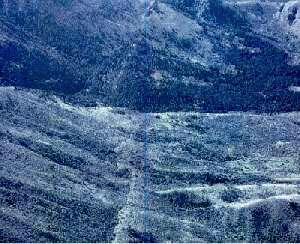|
ALPINE FAULT This is an intracontinental transform fault cross-cutting the two
islands of New Zealand and continues as the Karmadoc subduction zone in
Pacific ocean. This photo taken from a book shows recent activity
(displacement of alluvial fan ) along this fault. The estimated total
displacement along this fault since early Palaeozoic is of the order of
450 km. The fault affects the Proterozoic granite greenstone association.
Although not quite strictly true, most of the granite bodies occur to the
east of the fault. The fault is a boundary between the Pacific and Indo
Australian plates. Watch the BBC's online movie on bbc.co.uk as part of
the series titled Horizon by the BBC. This one is titled The man who moved
the mountains and also focuses on the movement of Indo-Australian plate
with experiment by Tapponier et al. As
one encounters younger rocks along the fault, the amount of displacement
gradually diminishes. The earliest movements appear to have begun during
the mid-palaeozoic. 
New Zealand's Alpine fault ·
N Island -
volcanic zone, oblique subduction (joins Tonga Kermadec arc to N). ·
S Island -
no volcanic arc, predominantly transpressional regime. ·
reason for
such quick changes? near pole of rotation. ·
main fault
strand - Alpine fault. ·
transpressional
(plate motion vector oblique to fault trace). ·
E side
uplift 17,000' in 4 +/- 2 Ma (Sheppard et. al. 1975). ·
450 km of
dextral offset: Dun mountain ultramafics provide displaced marker unit. Displacement amounts: ·
Molnar
& others - 330 km in last 10 Ma on basis of geology. ·
Wellman,
1973, - 300 km in past 10 Ma on basis of plate motions. ·
recent
movement rates .45 to 2.3 cm/year There are en echelon
folds developed and oblique motion on the main fault - can consider it a
coupled or only partially decoupled system system. Note northern faults forming - more pure transcurrent. Why? as thicken crust resistance increases, and more energy efficient to form new crust? |